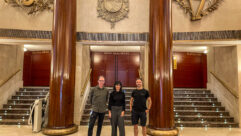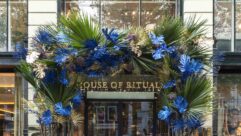House of Blues Web Exclusive
Oct 22, 2003 12:00 PM,
By Dan Keller
The French Quarter of New Orleans has long nurtured its reputation as the Big Easy’s party zone. The six-block-wide strip along the Mississippi hosts a staggering array of diverse dining and drinking establishments, all vying for the attention, and dollars, of tourists and locals alike.
All the more remarkable, then, that the House of Blues’ (HOB) New Orleans venue, on Decatur Street in the heart of the Vieux Carre, has not only held its own but also prospered. The oldest of the HOB organization’s clubs (with the closing some weeks ago of the original HOB in Cambridge) recently expanded into the adjacent building. “We’ve owned the building next door since opening in 1994 and were using it for storage,” says Chopper Brady, production manager for the club. “In 2000 we decided to build a Foundation Room on the third floor of that building and turned the second floor into a multiuse venue for special events. It got very popular, and quickly evolved into its own club, the Parish at House of Blues.”
Making Some Noise
The main club’s sound system is on a standard with the rest of the HOB chain, based around EV’s X-Array-series Xcn, Xcb, and Xds cabinets. The tight stage employs EAW SM- and SB-series monitors. EV P-3000-series amps power the full system. A Crest VX52 sits at front of house, with Klark Teknik DN3600 EQ. Lighting, as in all the HOB venues, is controlled by an Avolites Pearl console.
The adjacent Parish Room is something of a work in progress, Brady says: “The Parish originally inherited the main room’s old (EAW-based) system and has been gradually transitioning to a new EV system. I’m not sure exactly what we’ll have in here yet, but a small X-Array like next door would be perfect for this room.”
Another manufacturer long allied with HOB is Shure, which provides a full battery of mics and wireless systems for both rooms. “Those guys have been fantastic. They really care,” says Brady.
During the hob.com days, the club had a fully flown video system with five digital cameras. Although video is no longer a part of HOB’s standard repertoire, the New Orleans HOB is still a popular venue for taping one-off events. Norah Jones recorded her recent multiplatinum performance DVD there, and Dreamworks/SKG act Floetry has just released a live set taped at the club. “It’s an easy building to do video in,” says Brady. “We park the remote trucks right outside the door.”
Taking Care of Everyone
So what’s the secret to the club’s success? Brady is quick to praise those around him: “It starts with the home office. They give each venue manager a good set of tools to work with. There’s a real commitment to getting it right.”
Keeping on top of the technology to provide top-notch audio, lighting, and video is also key. “The strategic partnerships with companies like EV and Shure help us stay on top of new technologies,” Brady says. “In fact, we’re putting a new Heritage 2000 desk in here next week.”
The intimacy of the club is another factor that attracts artists to the club. The closeness of the stage allows a degree of contact with the audience that many of the bigger acts haven’t experienced in some time. “Johnny Cash played here a few years ago,” says Brady. “He’d been ill and hadn’t performed for two or three months. I was standing in the wings with him, and he kind of reached down and grabbed my hand and said, ‘I’m nervous.’ I said, ‘You? Nervous? Why?’ He said, ‘I’ve never gone two months in my whole career without doing a show.’ The curtain was closed, and the band was vamping behind the curtain. He walked out there, the announcer says, ‘Ladies and gentlemen, Mr. Johnny Cash.’ The curtain slid open, and he took about three or four steps backward. He told me afterwards, ‘Man, I haven’t seen an audience up that close in years.’ That was really one of those magic nights, having an artist like him performing there.”
In the end, however, Brady says it comes down to the people who work the club. “Our people are a big part of what makes things work here. We try to hire well. We bring on a wide spectrum of people, from Full Sail graduates to young band engineers and seasoned touring engineers. We do a good bit of training, too. Our chief audio engineer, Joe Francois, was the Meters’ original sound guy, so he’s seen a lot. When we send him a new person, he knows exactly what to teach them and what to let them learn on their own.”
Despite the challenges of working in the narrow streets of this historic district, the crew is remarkably dedicated. “The thing I find amazing is how these guys come in here, and even if it’s a tough day logistically, they just take a deep breath and get busy. We all work hard to make sure our challenges are not the artists’ challenges. If the club were a hassle to play, it’d be difficult to ask people to come here, but people go out of their way to play here again and again.”
Indeed, it seems the New Orleans HOB benefits from an extra helping of good old-fashioned southern hospitality. “Making people feel comfortable really plays into everything and makes for a great experience for the performer, the audience, and the crew,” says Brady. “As to equipment, if you really need it, you’re probably touring with it. But for anything else, if we can’t give it to you, we can at least get as close as possible. And we can make you real fat.”










